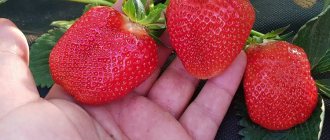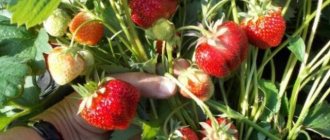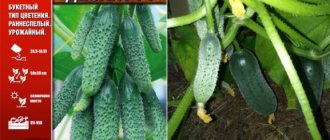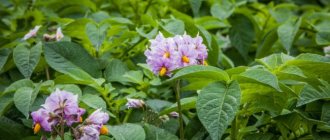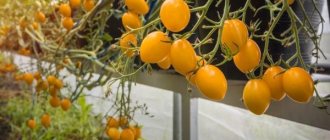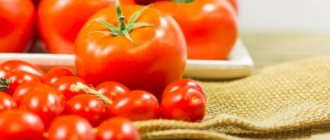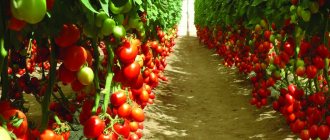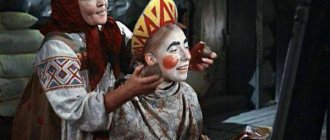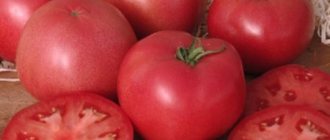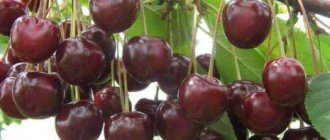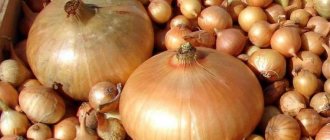Blue strawberry - what is it?
The blue variety of strawberry is not a hybrid, but a beautiful fiction. Most often the result of Photoshop. Or coloring with blue food coloring, sleight of hand and no cheating.
It is believed that this gardener’s blue dream exists in reality and can even be purchased. On the Aliexpress website. It's not expensive - a couple of dollars. But the usual red one grows, if you're lucky. Otherwise, it's a weed. Or nothing at all. The desire to order blue strawberry seeds depends on the level of excitement. Nobody guarantees the result.
Plant nurseries do not sell blue strawberry cuttings. Because there is simply no such thing in nature. Perhaps more.
It’s too early to get upset: it’s not at all difficult to get blue strawberries for decorative purposes.
Gardening experience
The experience of purchasing and further growing blue strawberry seeds, described by gardeners on numerous Internet forums, indicates the frequent dishonesty of suppliers. Instead of a tasty blue berry, you can grow a big beautiful weed from the purchased seeds, or less often the familiar red berry, or even nothing will sprout at all.
The question of trust in the producer of blue strawberry seeds remains open, since the agricultural practices of Chinese farmers are strikingly different from those adopted in our homeland. The value, usefulness, and most importantly, the safety of the planned harvest primarily depend on the quality of the biomaterial used.
Why is she blue (in theory)
Let's look logically. More precisely - biologically.
Pigments give color to individual parts of the plant. The presence of which is genetically determined. The pigment adds color by inserting itself in place of the destroyed green chlorophyll. This is how strawberries turn red. That is, for blue color it is necessary to introduce into it the gene that is responsible for the blue pigment. To do this, you need to play tricks with the genetic material. Which is not so easy to do.
So where do the legs of the blue dream come from? Back in 1998, a publication appeared in the United States according to which the Arctic flounder gene was introduced into garden strawberries. And for some reason it came from this that this is the reason for the blue color. The arctic flounder gene, like a natural antifreeze, adds winter hardiness to the plant. No more. It does not promote bluish coloration. Because it is gray in color. And in general he has non-color tasks.
How to get blue strawberries at home
No one had ever seen sky-colored garden strawberries in the garden. But despite this, it can be done. Without trying to outsmart genetics.
- paint the fruits with aerosol food coloring;
- grow one of the white varieties, for example, “Paintberry” or “White Swede”. Water with water containing diluted edible dye. But such troubles are not worth it. It's easier to use food spray.
It is more rational to use such an exotic berry for decorative purposes. Do not eat this store-bought fruit. If you are not sure about the safety of the composition.
Reviews on breeding blue strawberry species
Before purchasing its seeds, which promise a colorful miracle, doubt and check the information. It’s strange: on the Internet there is not a single video with a blue exotic harvest in the garden. There are plenty of photographs, thank Photoshop. Should you be alarmed?
The law of the market has not been canceled: demand creates supply. And it is considerable. Judging by the assortment on the websites. Reviews from those who decided to grow ultramarine strawberries are not flattering: the wrong thing has sprouted and ripened.
Antonina, 53 years old, Astrakhan “Ordered on the Internet. They sent seeds with a promotional gift. Not a single dark strawberry - reddish berries grew. Small as grapes"
Svetlana, 45 years old, Minsk “I was excited, I ordered it, it was sent quickly. The seeds have partially sprouted. It looks like a strawberry bush, but not a single berry has grown..."
Irina, 41 years old, Perm “As a novice gardener, I wanted to grow such a miracle on the window. The tomatoes worked, so I was hopeful. The blue berries did not ripen; instead, red strawberries ripened. How I wanted blue!))”
Let's sum it up
The grapes that come across in all the colors of the rainbow and the blue strawberries are clearly painted in Photoshop.
In this case we are talking about these grapes.
All reviews about the exotic blue berry, by and large, boil down to the fact that either nothing grew at all, or it was not a strawberry that grew, or it grew, but the usual red color. Moreover, the grown berry turned out to have a disgusting “plastic” taste.
Read also: Leeks: features of cultivation and care in Siberia (planting seedlings, when to harvest) photos and videos - eGreenhouse
On the other hand, seeds are inexpensive, and sellers sometimes send them as gifts. You can take a risk and buy not a sample. Apart from a couple of dollars for seeds and some soil for seedlings, you won’t have to lose anything. Perhaps someone, after all, will be able to boast of a photograph or video of blue exotic berries growing in the garden.
Is there a variety of blue, cyan and purple strawberries?
Like most myths, this one has a scientific basis. In 1998, the USDA National Agricultural Library published a paper on the transfer of an Arctic flounder protein gene to strawberries. In 2000, the New York Times wrote about the connection of genes.
The work was based on the fact that all organisms use the same genetic material (DNA). Therefore, it is possible to apply the ability to transfer genes between organisms that usually never interbreed to obtain new properties. An antifreeze gene from Arctic flounder was introduced into strawberries to extend the growing season in northern summer conditions . Some seabirds also have this gene.
However, the type found in Arctic flounder is considered the most effective at preventing freezing. And of course, this does not turn strawberries into fish, any more than using pig insulin turns people into pigs.
Where does this color come from?
The blue berry in the picture is photoshopped. Changing the color to the desired shade in a graphics editor is not that difficult.
Is it possible to see blue berries in real life? And this is also possible. For example, car antifreeze is colorless, and it acquires its hue thanks to artificial dyes, and not to the flounder gene, which is naturally gray in color. The dye can also be added to the berries to obtain the desired shade for advertising purposes . But strawberries grown from purchased seeds will be ordinary, with a classic red color.
Modern marketing tricks to deceive consumers
Of course, you always want to grow something unique. And the articles can be written quite convincingly to entice you to make a purchase. So they will appear again and again, advertising:
- wonderful rainbow roses that cannot exist;
- incredible multi-colored rainbow lemons, where each slice has its own color;
- rare square watermelons, which are possible because the growing fruit was placed in a special plastic mold and it grew in it;
- square pepper;
- blue, green, blue, orange or purple strawberries.
Typically, product marketing ploys are aimed at getting you to buy a particular product. And blue strawberries are the largest and most successful fake in the last 20 years. The rest are much simpler, but they bring owners no less income than the seeds of exotic but non-existent plants.
Have you ordered lobster at a restaurant? It does exist in nature, but lobsters are much more common and much cheaper. You can hardly distinguish the taste of lobster meat and lobster meat. Therefore, in a regular restaurant in the mid-price range, do not order exotic products. You will simply pay a lot more for a different, cheaper type of meat or vegetables.
If you still don’t read the ingredients of products, get yourself this useful habit.
Less obvious are the products in the retail chain. Here, most of the deceptions are based on a weak legislative framework on product labeling . Thus, in February 2021, a scandal erupted in the United States due to the fact that up to 20% cellulose was found in Parmesan of one national brand. Consumers were outraged. But they lost sight of the fact that the technological requirements of the manufacturing country do not require making cheese only from milk.
Do you like fast food? Then you probably love McDonald's nuggets made with fresh chicken. But the dish contains about 40 ingredients. And this hardly indicates fresh chicken meat. In addition, there is only 40% meat. This means the remaining 60% are offal and spices. Surely such a product is not the most beneficial for the body.
Even regular white bread is not perfect. Unlike whole grains, they are refined, which means they lose fiber and other beneficial substances. This bread can increase glucose levels in the body. Therefore, it should not be consumed by diabetics. But for others it is not very useful either.
The desire to buy something unique is natural. But remember that someone took into account your wishes a long time ago. Check the information received from other sources. Don't expect biologically impossible miracles. They simply don't exist. And try to use only those products whose composition you are sure is safe.
Where does this color come from?
Incredible natural diversity is presented in a wide range of colors.
Advances in human technology further expand natural splendor: purple roses, black tomatoes and even blue strawberries. On the one hand, a school biology textbook says that the chlorophyll contained in their cells is responsible for the color of leaves and unripe strawberries. Chlorophyll is colored green. As strawberries ripen, chlorophyll is destroyed, making way for pigments that give the fruit a wide range of colors. Theoretically, strawberries can take on a blue tint.
On the other hand, no matter how much you search on the Internet for a real photo of a blue strawberry, you won’t find it. Either the seeds and the berries are painted the same color, or the natural redness slips through the computer processing. It seems that blue strawberries or multi-colored strawberries are a miracle of modern technology, not selection. However, there are other versions.
The embodiment of the “blue dream”
Everyone understands that a rose is not a cornflower, and blue is not its characteristic color. Nevertheless, the blue rose exists; it was bred through many years of painstaking work by geneticists. Purple carnations also did not appear naturally, but all such achievements are described in scientific journals with detailed information about the methods of production and the authors of the resulting varieties.
It’s a different matter with blue strawberries, here you shouldn’t forget about this:
- information about it can only be found from seed sellers, and not at all in reputable publications, so is it worth believing them;
- We don’t eat flowers, unlike berries, therefore, after receiving an unusual color, the flower does not need to be checked for edibility and safety of the fruit, and there is no work on the edibility of blue strawberries;
- On the Internet you can see photos of berries, but nowhere are there any pictures of the beds or videos about their cultivation.
Gene modifications
There is plenty of information that the blue color of strawberries was obtained by introducing a gene from Arctic flounder. The use of genetic engineering methods in agriculture has its purpose:
- creation of new plant varieties;
- transfer of useful characteristics from species to species;
- improving the taste of the resulting crop;
- development of plant resistance to unfavorable environmental conditions.
However, it is unlikely that the Arctic flounder gene gives strawberries a shade of blue, but frost resistance is a more likely answer.
It is worth noting that there is still heated debate about the benefits and harms of genetically modified foods. In any case, you need to think carefully before eating blue or light blue strawberries.
Blue strawberry seeds
In online stores of planting material, nurseries in Russia and European countries, you cannot find seeds of either blue strawberries or blue strawberries. But on sites selling seeds from China, there will be no shortage of shades. Another question is what kind of seeds will come in the coveted bags with free delivery.
Growing strawberries from seeds is a labor-intensive process that requires adherence to basic agricultural technology. However, if you follow some recommendations, even a novice gardener can get an excellent harvest from seeds. When purchasing seeds you must:
- decide what size and flavor characteristics of berries you plan to obtain. Whether it will be a large, sweet or small berry, for consumption raw or prepared, depends only on personal preference;
- know what the expected fruiting frequency is. The market offers seeds of remontant strawberries, which bear fruit many times during the summer season. Ordinary strawberries, as a rule, bear fruit no more than once per season.
- check the integrity of the packaging and the expiration date of the seeds. You should purchase seeds in whole, undamaged packages with an unexpired expiration date. Growing strawberries from fresh seeds increases the likelihood of friendly and strong shoots.
- purchase seeds at specialized sales points. Stores that sell garden seeds usually guarantee the quality of the seeds. You can always get information from sellers in specialized stores about proper care for the selected variety.
- decide on the price. The cost of packaging seeds depends not only on the selected variety, but also on the degree of preparation of the seeds for future planting. More expensive seeds are often already treated for possible diseases and tested for germination. Advice for a novice gardener: you should pay attention to seeds in the mid-price category and avoid purchasing seeds on the street.
DIY berries
The ripening time of strawberries depends on the selected variety, early ripening, remontancy and can range from several weeks to a month. Is it worth waiting so long when you can surprise your friends and enjoy blue strawberries right now? You will need:
- 10−12 ripe red berries;
- blue food coloring;
- packaging of powdered sugar.
Rinse the berries thoroughly under running water and let dry. Then carefully, without touching the stalk, spray a thin layer of blue food coloring onto the berry. Let the berries dry. Place on a plate and lightly sprinkle with powdered sugar. .
Whether there are blue strawberries is up to the gardeners to decide, and the desire to purchase blue strawberry seeds depends only on the degree of curiosity and adventurism.
Preparing for landing
Growing strawberry seeds, including blue ones, is done through seedlings, using any convenient container. To successfully prepare seeds for sowing, you should follow some recommendations:
- Seeds are planted for seedlings at the end of February or early March. Planting seeds early will allow young plants to become sufficiently strong before transplanting into open ground.
- In order to protect future plants from diseases, the seeds are treated with a phytosporin solution before soaking.
- To speed up germination, seeds are soaked in melt water for about two days before planting. In this case, they should be wrapped in a damp base: a cotton pad will do, and then put away in a warm, dark place.
- The recommended temperature for seed germination is 27-30 degrees.
Growing seedlings
Prepared seeds are sown in containers for growing seedlings, at a distance of two centimeters from each other. The soil is moistened, and the container is covered with transparent glass or polyethylene. From the moment seedlings emerge, additional lighting should be provided for at least ten hours a day. Particular attention should be paid to maintaining optimal soil moisture. Excessive watering can provoke the appearance of mold, which is harmful to young plants.
The favorable temperature regime for strawberry seedlings is 25−27 degrees. When the first true leaf appears, the glass or polyethylene must be removed from the container, and after a week the plants will be ready for picking. In May, after the soil has warmed up, the seedlings are ready to be transplanted into open ground. It is worth noting that most strawberry varieties are unpretentious to the composition of the soil, which greatly facilitates the planting process.
Plants are planted at a distance of up to thirty centimeters from each other. To prevent rotting, the green mass, as well as the future harvest, must have sufficient air access. Growing strawberries from seeds is not that difficult. Getting a good harvest from strawberry beds depends on timely feeding and proper care.
Feeding and care
To successfully grow this crop, you must follow a few simple rules. Caring for bushes of any type comes down to five main points:
- timely watering;
- weed control;
- loosening the soil;
- fertilization;
- pest control.
Watering rules
Watering strawberry bushes depends on the climatic zone of its growth, soil moisture and frequency of rain.
To understand whether strawberries need watering, just dig a small hole in the garden bed and assess the soil moisture. If the soil at a depth of 5-7 centimeters is dry, then the plants should be watered. The watering schedule directly depends on the period of plant development. So, in the spring, after the snow melts and the beds dry out, it is necessary to water the bushes for the first time with warm water. The first watering will awaken the root system, pushing the strawberries to actively grow and form green mass. Then watering is done once a week, until flowering begins. After the first flower appears, it is advisable to switch to a drip irrigation system. If drip irrigation is not possible, the soil is moistened in the usual way. It is advisable to exclude water from entering the above-ground part of the plant.
Loosening the soil
Loosening the soil around strawberry bushes improves air exchange, which has a positive effect on the development of the root system. The first loosening is carried out in the spring, immediately after the soil warms up. The soil around the bushes is loosened twice before flowering, and after flowering - as necessary.
Hilling up bushes is a unique type of loosening. Hilling is required for strawberry bushes from the second year of planting in open ground, since additional roots begin to form at the base of the plant. You should hill up the bush very carefully, trying not to cover the young leaves with soil and not damage the delicate root system.
Neighborhood with other plants
Strawberries do not tolerate close proximity to other crops, and even less so to weeds. Therefore, the key to a successful harvest is the fight against various types of weeds. Periodic weeding and mulching the strawberry beds with a layer of sawdust will help prevent the growth of weeds. A sawdust layer of 5 centimeters thick is enough to stop the development of weeds. Instead of sawdust, you can mulch the crop with a layer of loose material that allows sufficient moisture and air to pass through.
Fertilizer application
Fertilizing strawberries is aimed at forming green mass of plants, strengthening the root system and increasing yield. Feeding is done three times:
- when three sheets appear;
- before flowering;
- at the time of fruiting.
For fertilizing, it is better to choose complex, soft-acting organic fertilizers. When applying complex fertilizers, you must strictly follow the instructions. In addition to complex fertilizers, ash, manure and herbal infusions are often used to feed strawberries.
Pest Control
Warm and humid weather is an ideal breeding ground for various types of pests of garden crops, including strawberries. The process of pest control should begin in early spring with spraying the crop with specialized preparations. To control pests you can use:
- purchased chemicals. The use of chemical industry products for pest control is advisable only in the case of massive and extensive infestation. It should be understood that the unwise use of chemicals for pest control can have a detrimental effect on the quality of the harvest.
- biological drugs. Biological preparations are aimed at combating fungal and viral plant diseases.
- old folk methods. Infusions of wormwood, tobacco, and pepper are often used as folk methods.
It is worth noting that the use of biological preparations and traditional methods is the most optimal and safe for humans and the plant itself.
Landing rules
Laurent f1 is quite unpretentious to cultivation conditions and soil composition. These strawberries can be cultivated in both chernozem and sandy loam soil with neutral or slightly reduced acidity. The area chosen for the variety is small, in the shape of an elongated rectangle, well moistened, inaccessible to winds and drafts - strawberries do not tolerate windy weather well.
Site preparation
A bed for Laurent seedlings is formed 4-5 days before planting the bushes. The strawberries in question need clean and loose soil, so the ground under them is first cleared of debris. The weeds are treated with a herbicide - not a continuous one, so that the strawberries are not deprived of nutrients.
After cleaning, the soil is loosened to the depth of a bayonet, or with a plow using a walk-behind tractor. At the same time, strawberries require high humidity, so loosening is carried out after heavy rain. The last stage of preparing the land for the variety is fertilizer. In the area under Laurent, a thin layer of ammonium nitrate solution is distributed, after which wood ash is added - 90-100 g per 1 m².
Germination of seed material
Laurent seeds begin to germinate in early March, in warm regions - at the end of February. The variety material is introduced into low oblong wooden boxes, scattering the seeds evenly over moist soil. The hybrid prefers enriched soil - humus, ash powder, sand and chicken droppings are added to the soil mixture. Laurent plantings are placed in a cool place for 3 days, then germinated at a temperature of 24°-26°.
Strawberries sprout a month after the seeds are planted. After the first shoots appear, the seedlings begin to be illuminated with lamps - Laurent requires 13-14 hours of light. When the strawberries sprout 2 true leaves, they are planted in separate pots - 2 sprouts in each. After this, the temperature is lowered to 16°-18° so that the seedlings of the variety do not stretch and waste energy on excessive growth.
Transfer of seedlings
Laurent seedlings are transplanted to the garden bed in the second half of May - early June, depending on weather conditions. To ensure that the transplanted strawberries do not die, the air temperature during planting should be no lower than 22°-23°, and the soil temperature – 14°-15°. The bushes of the variety are ready to be transferred to the ground after they have 6 true leaves. To prevent strawberries from experiencing stress after transplantation, a week before they begin to harden them in the fresh air - they are kept under a canopy for 15-20 minutes every day.
The day before planting, reddened leaves and excess root systems are cut off on the bushes of the variety. For the latter, the roots are carefully collected in a fist - everything that is not covered with the palm must be removed.
Strawberries are located in an area with a density of 5-6 bushes per 1 m². A distance of 15 cm is left between the plants of the variety, the width of the rows is measured at 25-30 cm. As the planting grows, Laurent is broken through so that the ripening strawberries receive enough sunlight.
